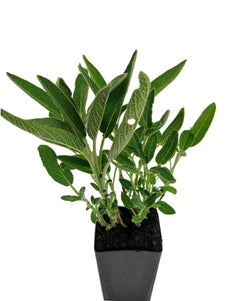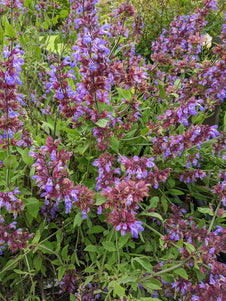



Sage
Sage

- In stock, ready to ship
- Inventory on the way

Usually available: All year
Life cycle: Perennial
Height: 90cm
Position: Full sun
Soil preference: Well drained
This is how we pack and send your Herb Plants to all states except TAS & WA
You will receive
- 1 Sage Herb Plant in a 50 X 75mm tube - General growing instructions
All of our Herb Plants are grown organically with certified organic potting mixes and fertilizers
Botanical Name: Salvia officinalis
General:
Most people know Salvia officinalis as the most common of all the garden varieties of sage. There are many varieties of Salvia, with up to 900 known species. Many of the more common herbaceous sage species also have different cultivars. Salvia varieties are very hardy, colourful and make a lovely addition to the garden, just to enjoy their natural beauty. In addition to their wonderful aroma, many have bright flowers and colourful foliage. Sage has many other benefits and while most serious gardeners realise this, sage is often not used to its full potential. The Latin word salvere means ‘to be saved’ and this reflects the wide ranges of medicinal uses for the many varieties of Salvia.
Specific
Common garden sage is a perennial ornamental herb, which may grow to approximately 90cm. The leaves are velvet green-grey and add a nice delicate appeal to a garden border. The 5-7 cm leaves are set in pairs along the stem. The flowers are a blue-purple and have a tube-like appearance. All the parts of the plant are fragrant with a strong scented odour and a bitter, astringent taste.
The natural habitat of Salvia is the dry, arid regions of the Mediterranean and Northern Africa, and some areas of the United States and South America. Salvia varieties require a lot of sun, and are ideally suited to Australian conditions. They are generally well adapted to harsh, dry and rocky environments.
Growing Conditions
Common sage flowers for three to four weeks, after which the flower stems need pruning. After about three years, the plant may get very straggly or woody and needs to be replaced. It is successfully propagated by cuttings, although an attempt can be made with seed. Some care is needed with young plants to allow them time to become established.
Salvia varieties, including common sage, do well in a wide range of soil types and garden conditions. Poor soil may be improved by adding organic matter and mulch will help to retain water in hot conditions. Sage is adapted to dry conditions and requires a well drained soil, so that the roots do not become water logged.
Salvia varieties also do well as container plants and should be planted into pots that will be suitable for the fully grown plant. The soil mix should be coarse, with extra perlite and organic fertiliser mixed through. Liquid organic fertiliser may also be used throughout the growing season.
Annual varieties may be grown together in a large container and discarded at the end of the growing season. Perennial varieties may also be discarded, if you intend to replant the following season or pruned after flowering and left over winter. In cooler regions, the plants may need some protection over winter. Longer growing, hardy varieties may be re-potted each year, in pots suitable for their size.
Culinary Uses
Common garden sage has a long history of culinary use. It is best used fresh as whole leaves, or ground up, but they can be dried very easily. To dry the leaves, prune the flowers and then collect the new growth that appears several weeks later. Be careful not to cut into old woody growth and make sure you shake off any dew or dampness. Hang them upside down in small groups of leaves in a dry and dark place until they are crispy. Strip the leaves whole, if possible, but it doesn’t matter if they break. If you make sure they are stored in a dark, air tight container they should keep their flavour for several months. They will be perfect for using in traditional chicken stuffing or with other meats, such as pork and sausages. Sage is also used in vinegars, as a garnish for salads, in cheeses and butter, and the fresh or dried leaves can even be brewed into a sage tea.
There are several varieties of common garden sage, Salvia officinalis, which may be used in cooking. In addition, there are also at least four other types of Salvia (sage) used for culinary purposes. We sell many varieties of sage, so please check our herb listings to see if there are any different uses in food preparation.
Medicinal Uses
Common garden sage is an extremely potent herb and has a broad range of medicinal uses. Women have used sage for menstrual problems, during menopause, to dry up milk flow when nursing is to cease (not for use during pregnancy or breastfeeding). Sage may also be used to aid digestive and gastric problems, including heartburn. There is growing evidence for the usefulness of sage for memory problems and there may be some benefit for depression. Sage is also anti-microbial and anti-inflammatory and has benefits when used topically for cold sores and as a gargle for other mouth problems.
Companion Plants
Good Companions: Carrots, cabbage, cauliflower and strawberries.
Bad Companions: Basil, rue, wormwood and cucumber.
All information provided on this website is for informational purposes only. Please seek professional advice before commencing any treatment.





